Act of Aggression Review – Act of War did it better
On one hand, Act of Aggression is a rather successful attempt at resurrecting traditional RTS games and continuing the legacy of C&C. On the other, it tries to become the spiritual successor to Act of War, but unfortunately, this is where it falls short.
The review is based on the PC version.
- C&C style oldschool RTS gameplay;
- War prisoners and banks;
- variety of effective tactics;
- multiplayer mode, tournaments, rankings.
- offers less than its 10-year-old prequel;
- boring single player campaign;
- run-of-the-mill AI in story missions;
- some unit balance issues and bugs.
French developer Eugen Systems are a veteran of the RTS genre. Creators of the successful Wargame series or R.U.S.E., with the recently released Act of Aggression remind us that Command & Conquer’s legacy isn’t done just yet. Still, Act of Aggression is more than just another reiteration of a 20 year old RTS classic that focuses on base and resource gathering; its ambitions also included succeeding the Act of War – its predecessor from 2005, created by the same studio. The developers intentionally follow their previous work when it comes to campaign planning, overall atmosphere, and numerous details, including the interface design. It’s been 10 years – that’s a lot of time to create something even better than before; unfortunately, if the bar was set too high the first time, even another 20 wouldn’t be enough. I’m afraid that’s what happened to Act of Aggression, seeing as it can’t hold its own against the now dated Act of War in many aspects. The reason for that, I believe to be the distribution of recognition between the single- and multiplayer modes. A decade ago, the designers focused on the former; this time around, the limelight’s on rankings and multiplayer team matches, while the single player campaign is treated as a supplement.

The plot, as usual, reminds us of one of Tom Clancy’s techno-thrillers – political turmoil and covert military operations using existing and barely existing equipment. Act of Aggression has a similar feel – in 2025, after a financial crash on the Chinese markets, the global economy finds itself plunged into severe recession. It would seem the cause of the calamity can be traced back to the Cartel – a rather shady organization that recently started gaining global influence. Against the Cartel, the significantly weakened U.S. of A. sends out its favorite mop-up team – the US Army, joining forces with the top secret UN task force Chimera.
That’s the most we can get out of it, because the dynamic montage of cutscenes (mostly rendered by the game engine and interrupted with short news broadcasts) makes it hard to keep up – the kaleidoscope of names, code signs, and mission orders can spin faster than the barrels of a Vulcan cannon. That’s the first big difference that comes to mind when comparing this game to Act of War. In the latter we had nearly an hour long movie featuring real actors, divided by gameplay segments. The acting could have been better, but the overall impression definitely made up for that, and I think that it was more engaging that way. Act of Aggression scores a point for showing the conflict from multiple perspectives. The main storyline’s focus lies on the “good guys” – the US Army and Chimera, but as the campaign progresses, we unlock Cartel’s missions as well, which allows us to see the other party’s outlook on the whole affair.
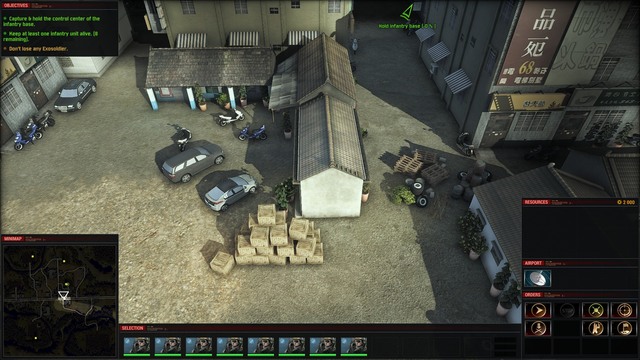
Further significant differences appear mostly in the gameplay and, albeit less important, in the map design. You may remember hundreds of civilians demonstrating on the streets of London – you won’t see them here. The terrain is devoid of any civilian population whatsoever. I admit, the environment is very detailed – there’s laundry left hanging outdoors, the streets are full of cars and scooters with recognizable brands (you can even read the registration plates on some of them), but the whole thing looks like a decoration – like the ones they build near nuclear test sites to estimate the effective yield of the bombs. The feeling of immersion from the previous game, as well as the overall atmosphere of storyline missions, was vastly superior.
The game’s visuals are not bad, but neither are they excelling – they provide us with a clear representation of units and the terrain and that’s that. The visual effects – explosions, smoke, or missile barrages – are the only thing that looks truly convincing. The sounds, on the other hand, disappoint – we hear less from our units than we used to in Act of War and the music nearly begged me to turn it off. Act of Aggression features neither naval units nor naval combat; our soldiers don’t earn experience in battle anymore, and the infantry units have forgotten how to go prone. There remains a vital question: were those things anyhow important and does the game suffer from their absence – after all, sometimes less is more. The market has us convinced that subsequent installments must improve and refine on the ideas featured in the earlier releases – to be better and more interesting; when something is removed, everybody starts booing.
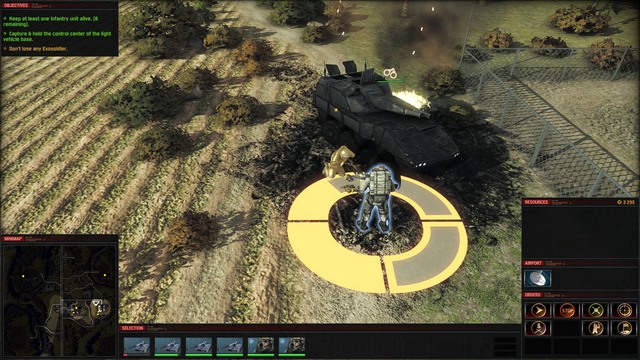
However, if we forget about Act of War for a moment and put aside the Act of Aggressions’ “sorryline” and that thing it claims to be acting, we get a 100% pure oldschool RTS gameplay. The choice between factions means more than cosmetic differences in unit’s appearances. Every side has its strengths and weaknesses. Cartel relies on advanced, very expensive technologies and stealth operations, the US Army uses conventional fighting force and its raw impact, Chimera is the most versatile army, possessing decent combat measures on every field, but excelling at none of them. The also factions make different use of the resources – the costs of buildings and units differ, so do things like aluminium applications and power consumption.
Our main sources of income are oil deposits, converted to cash on the spot; other than that we need the abovementioned aluminium and REE (rare earth elements) – later on necessary to produce superweapons. Additionally, we need electricity to power the structures in our base. What I found to be a very good idea was the random deposition of resources on the map and the fact that they are depletable – we may face a situation when there’s just not enough of them, to meet the needs of every side on the map. That’s where prisoner of war mechanics, featured in Act of War as well, comes into play. If we capture wounded enemy soldiers or the crews of destroyed enemy vehicles, we can exchange them for resources or send them to prison, which generates some credits. Another important source of money are the banks, scattered throughout every map. Essentially every building in the game can be manned with soldiers, making for a good defense point and, if the building happens to be the bank, granting us with stable revenue of credits. It would be wise to put additional guards in that area, because the enemy might want to reclaim the bank, for the same reasons.
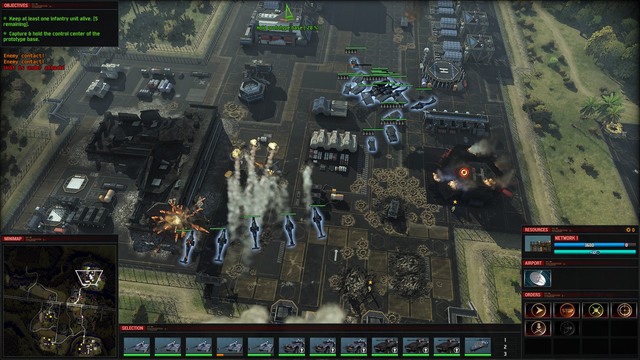
Although the game is set in the near future, on the battlefield we find many modern, but existing, weapon designs. F-22 Raptors and PAK FAs fly in the air, the helicopters are in no small part based on AH-64 Apache, Mi-24 or the Tiger and the US Army wrecks havoc on the ground with M1 Abrams tanks. Overall, we can use more than 70 types of equipment, and some of them can be upgraded or specialized (i.e. with Anti-Air or Anti-Tank missiles). That’s basically a good thing, but sometimes, because of the sheer amount of military hardware present, chaos on the field ensues. For example, often there’s no time or way to make sure which Humvee has a TOW-2 launcher and which one “only” a Mk.19 grenade launcher. I miss the ability to place your units in formations, but we can combine them in groups at least. The strange thing is I didn’t see this feature during the first few campaign missions - that serve as tutorial. Other than light and heavy armored and armed conventional vehicles, each faction possesses a superweapon, like the tactical nuclear warhead of the US Army or THOR orbital strike for the Cartel (C&C called, it wants the Ion Cannon back). To access them (and countermeasures to protect against them) we have to achieve the highest level of combat mobilization, but I’ll be the first one to admit, that a final assault on enemy base, using a downpour of nuclear warheads is a sight that fills you with satisfaction and definitely looks the part!
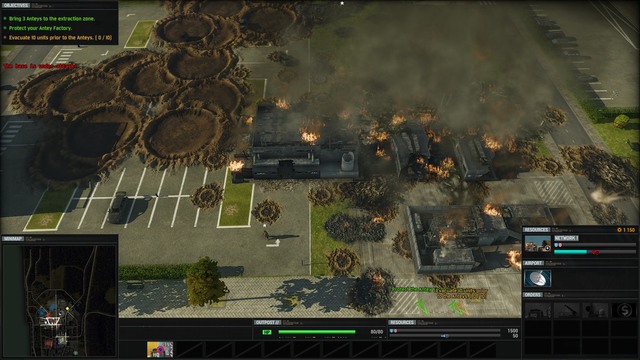
The essence of gameplay offered by Act of Aggression – employing various strategies (like stalling the enemy with economy and fortifications or hit-and-run raids on enemy’s resources and banks), utilizing unit traits and upgrades – all of this we get to know not during the campaign, but in skirmishes and multiplayer games. Apparently that’s the main feature of Act of Aggression, given how weak the single player campaign is. There are 20 dedicated multiplayer maps – both the skirmishes and multiplayer mode allow us to decide things like time limit, allowing or blocking superweapons, choosing factions available or starting points. Up to 8 players can form teams and play 4 on 4, 2 on 2 or 3 on 3, as well as take part in ranked solo or pair matches. As early as during the Beta tests, the creators have organized things like the “King of the Hill” tournament, and features like replay recording and spectator mode add to effective supervision of multiplayer events.
Deciding the final score of Act of Aggression was not an easy task. For one thing, we have a shoddy storyline – to say, it’s not quite as good as the one from 10 years ago, would still be giving it too much credit, accompanied by not quite impressive visuals and atmosphere to boot. However, if you’re expecting nothing more than a bona fide traditional RTS, featuring base and army development (with the addition of prisoners and banking), this game should satisfy your needs to a T. My score will reflect both points of view. Those fond of Red Alert and looking forward to a solid, engaging storyline will be undoubtedly disappointed, but those, who can take hours, discussing advantages of various tanks over various types of infantry and different methods leading to victory, can add up to two points to the final score. It would seem the creators have some general misconception, when it comes to politics. In reality, an act of war is expected to follow an act of aggression, and not the other way around. Given the quality of both games, I, for one, would rather see Act of Aggression released as a promising prequel.
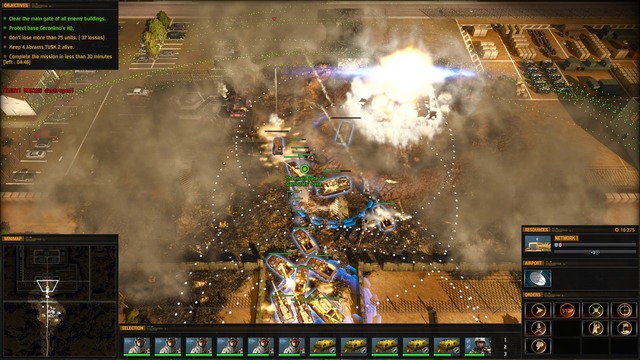

Darius Matusiak
Graduate of the Faculty of Social Sciences and Journalism. He started writing about games in 2013 on his blog on gameplay.pl, from where he quickly moved to the Reviews and Editorials department of Gamepressure. Sometimes he also writes about movies and technology. A gamer since the heyday of Amiga. Always a fan of races, realistic simulators and military shooters, as well as games with an engaging plot or exceptional artistic style. In his free time, he teaches how to fly in modern combat fighter simulators on his own page called Szkola Latania. A huge fan of arranging his workstation in the "minimal desk setup" style, hardware novelties and cats.
more
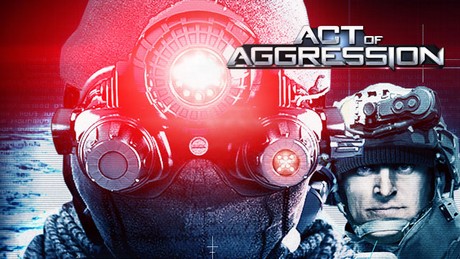
Act of Aggression Review – Act of War did it better
game review
On one hand, Act of Aggression is a rather successful attempt at resurrecting traditional RTS games and continuing the legacy of C&C. On the other, it tries to become the spiritual successor to Act of War, but unfortunately, this is where it falls short.

Frostpunk 2 Review: An Example That Risk Pays Off
game review
Frostpunk 2 is both a sequel and a new start for the franchise. Despite my concerns, this marriage turned out great.

Cities: Skylines 2 Review - A Revolution, 2.0, or 1.5?
game review
Cities Skylines is finally back with its sequel after a whole eight years. Part two brings sweeping, quality-of-life improvements, but has the formula stayed relevant after almost a decade?
